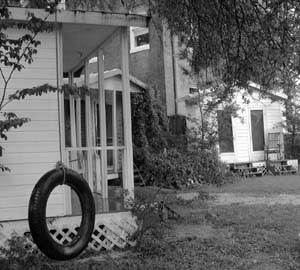Quote #1 chapter 1, page 6, paragraph 2
Maycomb was an old town, but it was a tired old town when I first knew it. In rainy weather the streets turned to red slop . . . [s]omehow it was hotter then . . . bony mules hitched to Hoover carts flicked flies in the sweltering shade of the live oaks on the square. Men's stiff collars wilted by nine in the morning. Ladies bathed before noon, after their three-o'clock naps, and by nightfall were like soft teacakes with frostings of sweat and sweet talcum. . . . There was no hurry, for there was nowhere to go, nothing to buy and no money to buy it with, nothing to see outside the boundaries of Maycomb County. But it was a time of vague optimism for some of the people: Maycomb County had recently been told that it had nothing to fear but fear itself.

Maycomb county
Setting/Time: Donna Wylie
The setting in a novel is the time, place and circumstance in which the plot of the novel takes place. The setting of this book greatly affects the plot, and events that occur. Had the setting been in Alabama in 2009, several things would not fit into the book, and the story would be changed completely.
The setting of To kill a mockingbird takes place in the fictional town of Maycomb located in the deep south of Alabama. This novel also takes place during the depression, specifically in 1935, which is mentioned on page 205, paragraph one, line five, the sentence is spoken by Atticus to the jury before they come about their decision; it reads, "there is a tendency in this year of grace, 1935, for certain people used to use this phrase out of context, to satisfy all conditions."
The time being 1935, the depression was occurring but had little affect on Maycomb, while it is affecting various parts of the United States in different ways, it was nothing new to Maycomb, children walking around barefoot, and having ringworm was the norm, and many citizens rode horses as a mode of transportation. There are several clues throughout the book that give away the time other than the most obvious one on page 205.
Quote one which is shown above mentions Hoover carts, when scout says, bony mules hitched to Hoover carts flicked flies in the sweltering shade of the live oaks on the square. President Hoover was president during the great depression, and the Hoover administration announced that there would be cars in every garage, being nobody could afford them. Many people would take two tires from their cars, built a car on top of the wheels and attach a mule.
The last line of quote one reads, But it was a time of vague optimism for some of the people: Maycomb County had recently been told that it had nothing to fear but fear itself. “We have nothing to fear but fear itself.” is a famous quote said by Franklin Delano Roosevelt in his first inaugural speech, made after the 1932 presidential election. This is a clue that states the book starts off sometime around 1932, or 1932, because Scout adds, recently.

The Finch house
Hoover carts are mentioned again at the beginning of chapter fourteen, Scout is mimicking things people say about her and Jem as they pass by, lines seven to ten reads,
..."yonder's some Finches." Turning to face our accusers, we would see only a couple of farmers studying the enema bags in the Maycomb drugstore window. Or two dumpy country wimen in straw hats sitting in a Hoover cart.
References to horses and mules were mentioned again on page 158 when Scout and Jem talks about Mr. Dolphus Raymond. Mr. Dolphus Raymond lurched by on his thoroughbred. “Don’t see how he stays in the saddle,” murmured Jem.
“Look at all those folks- you’d think William Jennings Bryan was speakin’.” This was said by Miss Stephanie Crawford on page 160, and Is another historical clue to the time. William Jennings Bryan was the U.S. secretary of State, and lived until he was 65, in 1925. This gives away that the time was around this era.
Towards the end of the book the setting is clear and clues are mentioned many more times like the depression, the current president, and the actual year is said. The setting in this book is effective described in chapter one. Scout describes it in quote, and on pages five through six one as a slow town, "A day was twenty-four hours long but seemed longer."
Possible questions for discussion:
- Keeping the setting and time in mind, pretend that Tom Robinson was white, and the Ewells black, but were respected, not how they were presented in the book, as white trash. How do you think the events would have turned out?
- Compare situations and events in this book with it’s time; examples can be, but are not limited to, the mad dog incident, the school pageant, summers in Maycomb. Take each event chosen and describe how they would change if the book had taken place in 1895, 1915, 1950, and 1970, that is if they would occur.
- Do you think tom Robinson would be proven innocent if Maycomb was a big city like New York? Explain.
No comments:
Post a Comment